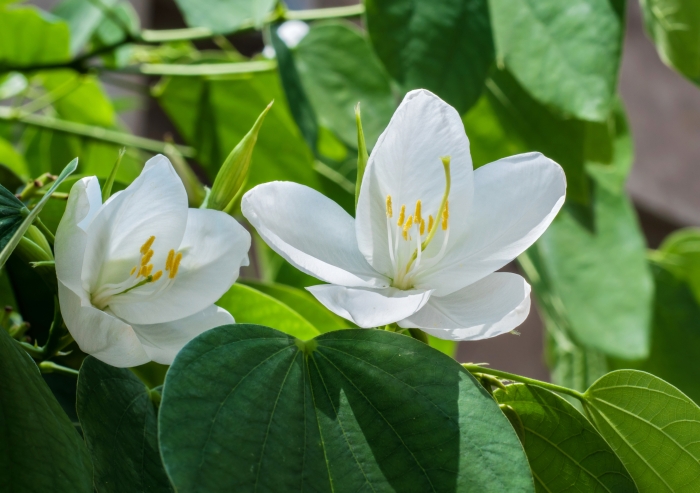Dwarf White Bauhinia
(Bauhinia acuminata)
Dwarf White Bauhinia (Bauhinia acuminata)
/
/

Joydeep
CC BY-SA 3.0
Image By:
Joydeep
Recorded By:
Copyright:
CC BY-SA 3.0
Copyright Notice:
Photo by: Joydeep | License Type: CC BY-SA 3.0 | License URL: https://creativecommons.org/licenses/by-sa/3.0 | Uploader: Joydeep | Publisher: Wikimedia Commons | Title: Bauhinia_acuminata_31_08_2012_(1).jpg | Notes: {{Information |Description ={{en|1=Yucca guatemalenis - Parrot Jungle, Miami}} |Source ={{own}} |Author =[[User:Ettore Balocchi|Ettore Balocchi]] |Date =2007-06-15 |Permission = |other_versions = }} [[Category:Yucca guate |













Estimated Native Range
Summary
Bauhinia acuminata, commonly known as Dwarf White Bauhinia, is a deciduous or semi-deciduous shrub or small tree native to open woodlands, forest edges, and plains in South and Southeast Asia, as well as Northern Australia. It typically grows to a height of 15-35 feet and a width of 10-20 feet. The plant is characterized by its distinctive, slightly lobed, heart-shaped leaves and its large, showy, white flowers that bloom in the late spring to early summer. The flowers are fragrant and attract pollinators such as bees and butterflies.
Dwarf White Bauhinia is valued for its ornamental flowers, which can add a tropical flair to gardens. It is often used in urban landscaping, as a specimen plant, or in mixed shrub borders due to its manageable size and attractive foliage. This species prefers well-drained soils and can tolerate a range of soil types, from sandy to loamy. While it thrives in full sun, it can also adapt to part shade conditions. Bauhinia acuminata is relatively low maintenance but can be susceptible to leaf spot and root rot if overwatered or planted in poorly drained soils. It is not known for aggressive roots or significant disease problems.CC BY-SA 4.0
Dwarf White Bauhinia is valued for its ornamental flowers, which can add a tropical flair to gardens. It is often used in urban landscaping, as a specimen plant, or in mixed shrub borders due to its manageable size and attractive foliage. This species prefers well-drained soils and can tolerate a range of soil types, from sandy to loamy. While it thrives in full sun, it can also adapt to part shade conditions. Bauhinia acuminata is relatively low maintenance but can be susceptible to leaf spot and root rot if overwatered or planted in poorly drained soils. It is not known for aggressive roots or significant disease problems.CC BY-SA 4.0
Plant Description
- Plant Type: Shrub, Tree
- Height: 15-35 feet
- Width: 10-20 feet
- Growth Rate: Moderate
- Flower Color: White
- Flowering Season: Spring, Summer, Fall
- Leaf Retention: Deciduous
Growth Requirements
- Sun: Full Sun, Part Shade
- Water: Medium
- Drainage: Medium
Common Uses
Bee Garden, Bird Garden, Butterfly Garden, Fragrant, Hummingbird Garden, Low Maintenance, Showy Flowers
Natural Habitat
Native to open woodlands, forest edges, and plains in South and Southeast Asia, and Northern Australia
Other Names
Common Names: Bell Bauhinia, St. Thomas’ Tree, White Orchid-Tree, Snowy Orchid-Tree, White Bauhinia, Yellow Bauhinia, Yellow Butterfly Tree, Fleur Du Sacre-Coeur, Kachnar, Kanchar
Scientific Names: , Bauhinia acuminata, Bauhinia linnaei, Casparia acuminata, Mandarus acuminata, Pauletia acuminata,
GBIF Accepted Name: Bauhinia acuminata L.